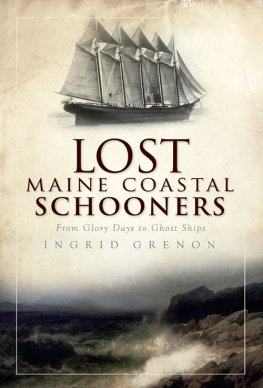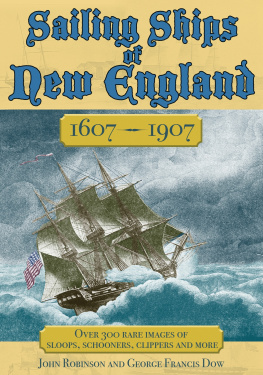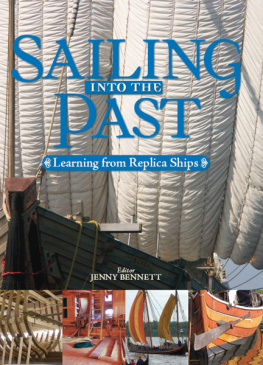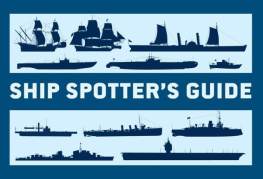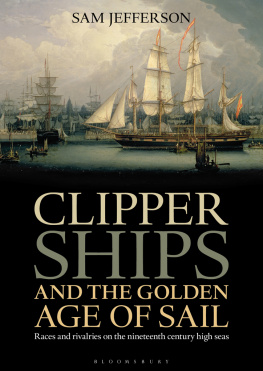DOVER MARITIME BOOKS
THE RIGGING OF SHIPS: IN THE DAYS OF THE SPRITSAIL TOPMAST, 1600-1720, R. C. Anderson. (0-486-27960-X)
A SHORT HISTORY OF THE SAILING SHIP, Romola Anderson and R. C. Anderson. (0-486-42988-1)
SIX TITANIC PAINTINGS CARDS, John Batchelor. (048640001-8)
100 HISTORIC SHIPS IN FULL COLOR, John Batchelor. (0-486-42067-1)
THE ART OF RIGGING, George Biddlecombe. (0-486-26343-6)
THE KEDGE ANCHOR; OR, YOUNG SAILORS ASSISTANT, William Brady. (0-486-41992-4)
STORY OF THE TITANIC: 24 CARDS, Frank O. Braynard. (0-486-25611-1)
PICTURE HISTORY OF THE NORMANDIE: WITH 190 ILLUSTRATIONS, Frank O. Braynard. (0-486-25257-4)
HISTORY OF THE BUCCANEERS OF AMERICA, James Burney. (0-486-42328-X)
LEARNING TO SAIL, H. A. Calahan. (O-086-40728-4)
ARCHITECTURA NAVALIS MERCATORIA: THE CLASSIC OF EIGHTEENTH-CENTURY NAVAL ARCHITECTURE, Fredrik Henrik af Chapman. (0-486-45155-0)
THE TITANIC COLORING BOOK, Peter F. Copeland. (0-486-29756-X)
THE BOOK OF OLD SHIPS: FROM EGYPTIAN GALLEYS TO CLIPPER SHIPS, Henry B. Culver. b(0-486-27332-6)
MEMOIRS OF A BUCCANEER : DAMPIERS NEW VOYAGE ROUND THE WORLD, 1697, William Dampier. (0-486-45726-5)
TWO YEARS BEFORE THE MAST: A PERSONAL NARRATIVE, Richard Henry Dana, Jr. (0-486-45802-4)
SHIP MODELS: HOW TO BUILD THEM, Charles G. Davis. (0-486-25170-5)
THE SHIP MODEL BUILDERS ASSISTANT, Charles G. Davis. (0-486-25584-0)
A GENERAL HISTORY OF THE PYRATES, Daniel Defoe. (0-486-40488-9)
SAILING BOATS FROM AROUND THE WORLD: THE CLASSIC 1906 TREATISE, Henry Coleman Folkard. (0-486-41099-4)
SAILING, SEAMANSHIP AND YACHT CONSTRUCTION, Uffa Fox. (0-486-42329-8)
THE MISSISSIPPI STEAMBOAT ERA IN HISTORIC PHOTOGRAPHS: NATCHEZ TO NEW ORLEANS, 18701920, Edited by Joan W. Gandy and Thomas H. Gandy. (0-486-25260-4)
PIRATES OF NEW SPAIN, 1575-1742, Peter Gerhard. (0-486-42611-4)
PIRATES: TRUE TALES OF NOTORIOUS BUCCANEERS, Henry Gilbert. (0-486-46148-3)
THE HISTORY OF PIRACY, Philip Gosse. (O-486-46183-1)
AMERICAN SHIP MODELS AND How TO BUILD THEM, V. R. Grimwood. (0-486-42612-2)
AMERICAS LIGHTHOUSES: AN ILLUSTRATED HISTORY, Francis Ross Holland. (0-486-25576-X)
OLD SHIP FIGURE-HEADS AND STERNS, L. G. Carr Laughton. (0-486-41533-3)
THE YOUNG SEA OFFICERS SHEET ANCHOR: OR A KEY TO THE LEADING OF RIGGING AND TO PRACTICAL SEAMANSHIP, Darcy Lever. (0-486-40220-7)
THE CRUISE OF THE SNARK, Jack London. (0-486-41248-2)
THE PIRATES OWN BOOK: AUTHENTIC NARRATIVES OF THE MOST CELEBRATED SEA ROBBERS, Marine Research Society. (0-486-27607-4)
ON BOARD THE TITANIC: THE COMPLETE STORY WITH EYEWITNESS ACCOUNTS, Edited by Logan Marshall. (0-486-45098-8)
PICTURE HISTORY OF THE SS UNITED STATES, William H. Miller, Jr. (0-486-42839-7)
PICTURE HISTORY OF THE QUEEN MARY AND QUEEN ELIZABETH, William H. Miller, Jr. (0-486-43509-1)
GREAT SHIPS IN NEW YORK HARBOR: 175 HISTORIC PHOTOGRAPHS, 1935-2005, William H. Miller, Jr. (0-486-44609-3)
PICTURE HISTORY OF GERMAN AND DUTCH PASSENGER SHIPS, William H. Miller, Jr. (O-486-42063-9)
PICTURE HISTORY OF AMERICAN PASSENGER SHIPS, William H. Miller, Jr. (O-486-40967-8)
See every Dover book in print at www.doverpublications.com
TO THOSE unknown craftsmen and mariners upon whose skill and seamanship is founded the progress of ship-building through the ages; to the memory of the known illustrious designers, master shipwrights and artists of a later day, Pett, Shish, Puget; to the projectors and builders of the frigates, packets and clippers of our own era, Humphrey, Griffith, and MacKay, and to all lovers of ships, be they mariners or landlubbers, this book is humbly and affectionately dedicated.
This Dover edition, first published in 1992, is an unabridged, slightly corrected republication of the Flotilla Edition (750 numbered copies) of the work originally published by Doubleday, Page and Company, Garden City, New York in 1924 under the title, The Book of Old Ships: And Something of Their Evolution and Romance/Wherein will be found drawings and descriptions of many varieties of vessels, both long and round, showing their development from most remote times; the portraiture of their progress, their garnishment, etc., etc., etc./Together with DIVERS DISSERTATIONS upon the Origins of Shipping; also an APPENDIX wherein will be discovered to the inquisitive much information appertaining to the ANCIENT USES and customs of the sea and mariners/Illustrated with a variety of original designs of shipping compiled from authentic sources. The illustration on page vi originally appeared in color. Some of the material in this edition has been moved from the original locations.
DOVER Pictorial Archive SERIES
This book belongs to the Dover Pictorial Archive Series. You may use the designs and illustrations for graphics and crafts applications, free and without special permission, provided that you include no more than ten in the same publication or project. (For permission for additional use, please write to Dover Publications, Inc., 31 East 2nd Street, Mineola, N.Y. 11501.)
However, republication or reproduction of any illustration by any other graphic service whether it be in a book or in any other design resource is strictly prohibited.
Library of Congress Cataloging in Publication Data
Culver, Henry B. (Henry Brundage), b. 1869.
[Book of old ships and something of their evolution and romance]
The book of old ships: from Egyptian galleys to clipper ships / Henry B. Culver; illustrated by Gordon Grant.
p. cm.(Dover pictorial archive series)
Originally published: The book of old ships and something of their evolution and romance. Garden City, N.Y. : Doubleday, Page, 1924.
Includes bibliographical references.
9780486156897
1. ShipbuildingHistory. I. Grant, Gordon, 18751962. II. Title. III. Series.
VMIS.C9 1992
387.21dc20
92-21987
CIP
Manufactured in the United States by Courier Corporation
27332606
www.doverpublications.com
Table of Contents
.... Whom once men tended like a queen... Let be... She is one with all things that have been
PREFACE
NAVIGATION by man of the waterways of the earth is believably co-eval with his earliest activities. The scientists tell us that his life was then nomadic. In the course of his migrations in search of food or more congenial conditions of climate, he would of necessity have met with bodies of water too deep or too wide to be crossed by fording or swimming. In fishing and in hunting, too, he would employ the most primitive form of aquatic conveyancea floating log. As the next step he would naturally join several logs together by means of wythes or creeping plants, thus enabling him to float dry shod. The difference between this, the simplest form of marine construction, the raft, and the greatest ocean leviathan of to-day is one of degree only.
Supported by his log or seated upon his raft, the next question was one of propulsion; a paddle of a flattened piece of wood was, after hand and foot, the obvious answer. Soon the problem demanded the invention of a means of directing the unwieldy craft; a similar paddle used as a rudder was the solution. Immediately the presence of a further factor, the effect of the wind upon the floating mass, became evident. Paddling with a favouring breeze was manifestly easier than with none or against a contrary one. Perhaps, originally a bough extending up into the air from the log, or the increased velocity of his raft when an erect position thereon offered a greater resistance to the wind, served to call attention to the aid offered by such an obstruction. To the simple but reasoning mind of the man-animal, such assistance could not be disregarded upon the next voyage. Ultimately, from the skin of some wild beast, man devised his first harness for the wind, a sail.


